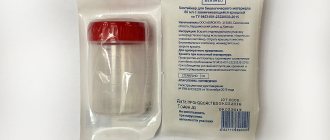Analysis for the detection of cortisol in urine
The urine contains free hydrocortisone, not bound to protein. The analysis provides complete information about the disease. It is possible to obtain reliable indicators only by collecting daily urine. Typically, this study is carried out to diagnose endocrine pathologies and dysfunction of the adrenal glands.
Reason for appointment
If the doctor suspects adrenal dysfunction based on the patient’s condition, he recommends doing a 24-hour urine test for cortisone to exclude or confirm diseases. Indications for the study are the presence of the following conditions:
- muscle weakness;
- high blood pressure;
- accelerated sexual development in children;
- increased hair growth in women;
- changed skin surface tone;
- increased activity of the adrenal glands;
- oncological diseases;
- diabetes mellitus;
- a sharp increase or decrease in body weight without obvious reasons;
- children's developmental delays;
- menstrual irregularities, difficulties with conception;
- spontaneous abortions;
- osteoporosis.
Investigation is recommended if the following symptoms appear:
- hand tremors;
- increased sweating;
- nausea;
- dizziness;
- headache;
- dry mouth.
It is often recommended to conduct a urine test to determine the level of hydrocortisone during long-term use of glucocorticosteroids.
Specifics of the event
The study of the collected analysis is carried out in laboratory conditions using a specialized technique. To get the result, the patient will only need to bring 100 ml of daily urine. It will take 3 to 5 days to complete the diagnosis. The data is recorded on a special form and sent to the attending physician.
Decryption of data acquisition
The analysis collected must be deciphered by the doctor who referred you for the study. The results are assessed taking into account generally accepted standards, the patient’s condition, and medications taken. The normal lower limit of cortisol is 39 mcg/dL. Upper – 348 mcg/dl.
It is important to know! If a patient submits urine for analysis for the first time and has a serious deviation from the boundaries, then, as a rule, a repeat test is prescribed to exclude incorrect preparation.
Interpretation of the analysis may vary. It depends on the laboratory that carries out the processing and on the type of equipment installed in it. If the person being tested exhibits deviations from the norm, it is recommended to have urine tested several times a month. In addition, an additional examination of saliva and urine for metanephrine and normetanephrine is prescribed, which allows assessing the functioning of the adrenal glands.
What is cortisol
Cortisol is a hormone of the adrenal cortex. It is responsible for the stable functioning of the entire body under stress and various physiological conditions. It belongs to the steroid hormones that regulate carbohydrate metabolism.
The body's energy balance directly depends on the production of this hormone. The concentration of free cortisol is determined both in the urine and in the blood. Cortisol levels in the blood can vary throughout the day. So, its level in the blood is higher in the morning than in the evening.
And free cortisol in urine does not depend on the time of day and has a constant value. Thus, it is the determination of the level of this hormone in the urine that has special diagnostic significance, for example, in Itsenko’s disease.
- How to correctly collect daily urine for analysis, how to decipher the results?
Urine collection
Collecting 24-hour urine for cortisol includes the following sequential steps:
- First of all, you need to prepare a glass vessel with a volume of 2-3 liters. It is recommended to sterilize the container by steaming, dry it and pour 1 g of boric acid powder into it. This measure will prevent the contamination of urine with pathogenic microflora and normalize the level of urea in it.
- The urine that has accumulated in the bladder overnight is not used for collection in a glass vessel. It is recommended to start collecting biomaterial with 2 urinations.
- The last urine collection should be carried out the next morning.
- It is recommended to store the finished glass vessel with biomaterial for research in the refrigerator or other cool place.
- From the resulting volume of biomaterial, it is recommended to take 100 ml into a sterile container, after first shaking the vessel with daily urine.
- The resulting volume of biomaterial must be delivered to the laboratory within 2 hours.
How to take it
To take the test, you need to collect urine excreted throughout the day. To do this, you need to prepare a container of at least 2 liters (dry and clean) and take a special preservative from the selected laboratory. The first portion of urine after waking up is not needed for analysis; it goes directly down the toilet.
Subsequent urination after toileting the external genitalia is carried out in a prepared container. A preservative given in the laboratory is added to the first portion of collected urine, the vessel is closed with a lid and, shaking, the urine is mixed with the preservative. Such contents should be stored at a temperature from +4 to +8 degrees Celsius (do not freeze under any circumstances!).
All subsequent urinations during the day and the first one after sleep the next day are collected in a prepared container. It is important to carry out hygienic procedures for the external genitalia before each urine collection and mix the resulting urine using the rocking method.
After collecting all the urine, it is thoroughly mixed and poured up to 100 ml into a clean container. A note with the indicated amount of all collected urine must be added to the prepared material and taken to the laboratory within the next two hours.
Analysis algorithm
As mentioned above, preparation for analysis is important. It is as follows:
- Before taking the test, certain foods are excluded from the diet: salty, sour, spicy, as well as foods that color the urine (carrots, beets, etc.).
- For 2-3 days, the use of hormonal contraceptives is prohibited, and hormone therapy (androgens and estrogens) is also canceled.
- For 3-7 days (as directed by the attending physician), diuretics are excluded.
- 5-7 days before the test you should quit smoking and alcohol.
- On the day of the analysis, nervous and physical stress should be avoided.
- Also, on the day of the test, you may not adhere to your usual drinking regimen.
5-7 days before taking a cortisol test, you should stop smoking and alcohol.
Before collecting the test, you should be careful about hygiene procedures and first wash your genitals with warm, clean water. If a woman has this period during menstruation, then the analysis is postponed after their end. If there is an urgent need for this particular study, it is recommended to use a hygienic tampon.
Submission of analysis
In the laboratory where the analysis will be carried out, the patient needs to take a preservative. Next, the selection occurs according to the following scheme:
- The first (after night) portion is not collected and is flushed down the toilet.
- The first collection is made between 8 and 10 am. A preservative is added to the portion and mixed thoroughly.
- Next, all the secretions are collected in one container with a volume of at least 2 liters and stored in the refrigerator (but not in the freezer).
- The penultimate collection is carried out from 20.30 to 22.00 hours.
- The last time urine is collected is in the morning hours of the next day (from 8 to 1 am).
During the day (or 24 hours), you need to collect at least 2000 ml of analyzed material.
For this analysis, you need clean, dry glassware or special disposable containers, which must also have a lid.
Before submitting the material to the laboratory, it should be kept in a cool, dark place. The bottom shelf of the refrigerator is most suitable for this.
The next day, the biomaterial is thoroughly mixed, a portion of about 100-150 ml of urine is drained from it into a separate container and submitted to the laboratory for research.
Preparation Tips
Proper preparation for analysis will allow you to obtain the most reliable results. To do this, you will need to exclude salty, spicy, hot and smoked foods from your diet the day before the test. Refrain from eating colored vegetables - carrots, pumpkins, beets.
A couple of days before the diagnosis, stop taking hormonal, diuretic drugs, oral contraceptives, and do not drink alcohol or energy drinks. Don't smoke, avoid physical and emotional stress.
Before the analysis itself, it is necessary to wash the genitals. Women should not get tested during their menstrual periods. If necessary, you need to use a tampon.
Medical standards
The main part of the hormone (up to 90%) is bound to proteins. Bound cortisol continuously moves throughout the body with the bloodstream, taking part in metabolic processes. The remaining part (about 10%) is in an unbound, free state. Free cortisol is excreted in the urine.
- Adrenal glands: symptoms and causes of the disease, their diagnosis and treatment
Hormone synthesis is controlled by the pituitary gland through the production of adrenocorticotropic hormone. An increase in the level of this hormone is a sign of low cortisol concentration, a decrease is a sign of increased production of the hormone by the adrenal glands.
Cortisol concentration is not constant. In the morning the level increases slightly, and in the evening the concentration decreases. It has been noted that women are more often susceptible to such surges in cortisol concentrations, which may be due to their greater emotional lability.
Cortisol is determined mainly in urine, since it disintegrates quite quickly in the blood. There are a large number of factors that influence the concentration of cortisol in the blood. Even such a seemingly insignificant fact as taking biomaterial from a vein can provoke a sharp release of the hormone into the blood. Which, naturally, will distort the final result. Therefore, it is not advisable to test blood to determine cortisol levels.
Equally dangerous is the state of excess and lack of cortisol production.
- With hormone deficiency, rapid loss of body weight, decreased blood pressure, general weakness, deterioration of the thyroid gland and liver, and frequent neuroses are observed. A prolonged lack of cortisol can provoke an adrenal crisis - the basis of a panic attack.
- Excess cortisol contributes to increased blood pressure, decreased reaction speed and functioning of the central nervous system, the development of osteoporosis, rapid weight gain, and increasing depression. In the long term, increased levels of the hormone provoke the development of diabetes mellitus and oncological processes.
In medical practice, the following standards for free cortisol in daily urine are accepted:
- Children (under 14 years old) – 6-74 nanomol/liter.
- Teenagers (under 18 years old) – 14-152 nanomol/liter.
- Adults (18 and older) – 55-248 nanomol/liter.
In women during pregnancy, the concentration of the hormone increases significantly and exceeds accepted norms by 3-5 times. However, this condition is physiological, since the period of gestation is a stressful situation, and by increasing the level of cortisol, the body tries to stabilize the situation.
General information about cortisol
Cortisol is a hormone produced by the adrenal cortex.
Its main functions:
- protecting the body from psychological stress (stress);
- regulation of blood pressure (BP);
- participation in general metabolism (metabolism).
Approximately 90% of cortisol constantly circulates in the blood and is involved in metabolism using carrier proteins (“bound cortisol”). The rest of it is in an unbound state. About 1% of “free cortisol” is excreted in urine per day. But even such a small amount of the hormone makes it possible to accurately determine its total concentration in the patient’s body.
- Increased glucose in urine: what does it mean, what diseases does it indicate and how to treat them
Cortisol production is regulated by adrenocorticotropic hormone (ACTH), which is produced in the pituitary gland. An increased level of ACTH signals insufficient production of cortisol and, conversely, a decrease in the concentration of ACTH is characteristic of its excess. In this regard, the daily level of cortisol in the blood and/or urine may change.
Insufficient levels of the hormone provoke rapid weight loss, chronic lethargy, hypotension (low blood pressure), muscle weakness and abdominal pain. A decrease in cortisol concentration due to severe stress in a patient can cause the development of adrenal crisis, a life-threatening condition that requires urgent medical attention.
Exceeding the concentration of the hormone leads to weight gain up to obesity, the development of diabetes mellitus and hypertension (high blood pressure). The skin becomes thin and pale, stretch marks (striae) appear on the sides of the abdomen.
Norm of cortisol in urine
Testing for cortisol in 24-hour urine analysis is carried out using a special technique. The specified volume of collected urine is necessary to calculate the daily amount of cortisol.
The result of the study largely depends on the patient himself, or more precisely, on how correctly the preliminary preparation and collection of the biomaterial itself was carried out. Cortisol levels in women and men do not differ by gender, but vary depending on age.
In children, 24-hour urine cortisol ranges from 6 to 75 nmol/L (nanomoles per liter) per day.
In adolescents, this figure varies from 15 to 154 nmol/l.
Free cortisol in daily urine in adults normally ranges from 55 to 249 nmol/l.
Thus, the older the person, the higher the indicators.
Decoding the result
Only a doctor can decipher the result. Indeed, when assessing it, you need to take into account not only the figure given by the laboratory, but also the correctness of following all recommendations the day before and during the urine test, pay attention to additional points that could lead to a falsely high or falsely low result, and the clinical manifestations of the disease. It is worth remembering that in pregnant women, cortisol is normally increased by 2 to 5 times.
Increased levels in urine
The reasons for the increase in free cortisol in the urine are considered to be stress, chronic fatigue, disruption of the daily routine, the third trimester of pregnancy, obesity, a diet rich in carbohydrates, and participation in strenuous sports. An increase in the amount of the hormone in urine may indicate the development of serious diseases (for example, Cushing's syndrome, tumors in the thymus, lungs, adrenal glands or pancreas, as well as long-term depression). The most common cause of increased concentrations of free cortisol in urine is diabetes. With a reduced concentration of glucose in the blood at night, there is an increase in hormone synthesis in the adrenal glands, as cortisol stimulates gluconeogenesis.
Indications for analysis
A study of biological fluid for cortisol is performed in cases of suspicion of Itsenko-Cushing's disease, Addison's disease and other pathological changes. Signs for use are:
- unstable pressure in the arteries;
- weight change without obvious reasons;
- increase in sugar content;
- formation of stretch marks on the abdomen;
- pigment spots on the skin;
- dystrophy or atrophy of tissue in the muscles;
- osteoporosis, numerous fractures;
- abnormalities during menstruation in women;
- constant feeling of fatigue;
- slow growth (for children);
- diagnosing dysfunction of the adrenal glands or pituitary gland;
- studying the results of treatment of chronic hypertension - this is especially true if there are no pronounced clinical indicators;
- control over the treatment of endocrine system diseases using glucocorticosteroids;
- examination of people with symptoms that are inappropriate for their age category;
- manifestations of an abnormal nature in the pituitary gland or adrenal glands.
Daily cortisol in urine is analyzed when diagnosing a huge number of diseases. The most serious of them are a malfunction of the adrenal glands - Itsenko-Cushing syndrome, Addison's disease. Other prerequisites for analyzing the hormone in 24-hour urine:
- diagnosis of pituitary gland dysfunctions and adrenal gland diseases;
- changes in blood pressure;
- increase in blood glucose;
- weight gain or sudden decrease without objective reasons;
- development of long red stretch marks on the skin of the abdomen;
- manifestations of age spots;
- dystrophy (weakening) or atrophy (death) of muscles;
- brittle bones, osteoporosis;
- chronic fatigue;
- disruption of the menstrual cycle;
- the presence of secondary sexual characteristics of men in women;
- slow growth in children;
- lack of results of treatment for chronic hypertension;
- monitoring the condition during therapy of the endocrine system using glucocorticosteroids;
Factors influencing information content
There are quite a few factors that can influence the level of cortisol in the blood. Increased concentrations of hydrocortisone are observed in pregnant women. It is also possible to increase the hormone after surgery, various injuries, or with constant severe stress. Its level also increases when taking certain drugs. These include: Danazol, Veroshpiron, Morphine, Phenothiazine and others, as well as oral contraceptives.
Corticosteroid therapy also affects hormone levels. Bad habits (alcohol abuse, smoking) have a negative impact. Medications that reduce the concentration of cortisol in the body include: Prednisolone, Ketoconazole, Dexamethasone, drugs containing thiazides, ethacrynic acid.
A medical condition such as kidney failure may affect hydrocortisone levels.
Kidney failure may affect urinary cortisol
The patient himself can also influence the result by spoiling the material through improper collection or storage.
Main reasons for deviations
If the level of 24-hour urine cortisol is changed, in this case the doctor will order a repeat test or make a final suspected diagnosis. Increases and decreases in levels can provoke various diseases.
If the indicators are overestimated, this indicates:
- Possible tumors of the hypothalamus of various etiologies;
- Severe obesity;
- Various neoplasms, including adenomas, cysts, tumors on internal organs;
- Excessive production of thyroid hormones by the thyroid gland.
You should not exclude or confirm any suspicions on your own. To correctly interpret urine cortisol tests, you should consult a doctor. He will look for the reason for the decrease in data in the following possible pathologies:
- Brain tumors;
- Thyroid dysfunction;
- Insufficiency of the adrenal glands;
- Asthma or other bronchial diseases;
- Constant use of medications, especially hormonal ones.
You should go for a urine test for cortisol on the recommendation of your doctor. You should also go to him with their results to get a comprehensive consultation.
Reasons for changes in hormone levels
An increase or decrease in cortisol levels can provoke numerous diseases of the internal organs. The following ailments affect the increase in hormonal levels:
- the occurrence of tumors of various etiologies in the hypothalamus;
- cysts or adenomas in the pituitary gland;
- hyperfunctionality of the adrenal glands and increased production of glucocorticosteroid substances (Cushing's syndrome);
- neoplasms in the internal and reproductive organs (bronchi, testicles and ovaries, adrenal glands);
- increased production of thyroid hormones by the thyroid gland;
- severe obesity.
Reasons for decreased free cortisol:
- bronze disease - adrenal insufficiency;
- tumor formations in the brain;
- functional thyroid insufficiency;
- long-term use of hormonal steroid drugs;
- pathologies of connective tissues, bronchi (asthma).
| Parameter | Reference values | Units |
| Cortisol (Cortisol-U) | 11.8-485.6 | nmol/day |
| Increasing values | Decrease in values |
|
|
We draw your attention to the fact that the interpretation of research results, diagnosis, as well as the prescription of treatment, in accordance with Federal Law No. 323 “On the fundamentals of protecting the health of citizens in the Russian Federation,” must be carried out by a doctor of the appropriate specialization.
"["serv_cost"]={amp}gt; string(3) "920" ["cito_price"]={amp}gt; string(4) "1840" ["parent"]={amp}gt; string(2) "22" [10]={amp}gt; string(1) "1" ["limit"]={amp}gt; NULL ["bmats"]={amp}gt; array(1) { [0]={amp}gt; array(3) { ["cito"]={amp}gt; string(1) "Y" ["own_bmat"]={amp}gt; string(2) "12" ["name"]={amp}gt; string(27) “Urine (daily)” } } }











